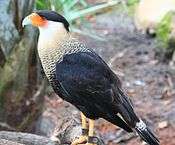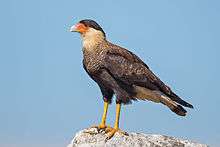Caracara (genus)
Caracara is a genus in the family Falconidae and the subfamily Polyborinae. It contains two extant species, the northern crested caracara and the southern crested caracara; and one extinct species, the Guadalupe caracara. The only visible difference between the two living species is that the southern species possesses more barred plumage than the northern species. The minor physical differences between these species resulted in their originally being treated as conspecific.
| Caracara | |
|---|---|
 | |
| Northern crested caracara (Caracara cheriway) | |
| Scientific classification | |
| Kingdom: | Animalia |
| Phylum: | Chordata |
| Class: | Aves |
| Order: | Falconiformes |
| Family: | Falconidae |
| Genus: | Caracara Merrem, 1826 |
| Species | |
and see text | |
 | |
| Range of the genus Caracara | |
| Synonyms | |
|
Polyborus | |
Appearance
The crested caracara is distinguished by its long legs and medium size.[1] The birds can reach a length of 49–58 cm (19–23 in) from head to tail.[2] There are usually four points of identification of the caracara: strikingly white markings on the neck, the tip of both wings, and the tail.[3] Along with their medium length, the caracara also has a wingspan of 122–129 cm (48–51 in).[4] When flying, the caracara is often noted to have a pattern on their underside that looks like a cross.[5]
Behavior
The behaviors of caracaras are considered quite strange in relation to other falcons.[6] The bird is often seen walking on the ground in search of prey, using its long legs to maneuver its landscapes.[7] In addition to a preference of walking over flying, the birds also create close bonds with their mates.[8] These birds will also harass large species of birds in order to take the food they caught.[9] In flight, this bird is known for having very direct flight. It does not soar for leisure.[10]
Taxonomy
The northern and southern crested caracara are the only extant members of the genus Caracara.
| Image | Scientific name | Common name | Distribution |
|---|---|---|---|
 | Caracara cheriway | Northern crested caracara[11] | Cuba, northern South America (south to northern Peru and northern Amazonian Brazil) and most of Central America and Mexico, just reaching the southernmost parts of the United States, including Florida |
 | Caracara plancus | Southern crested caracara[11] | Tierra del Fuego in southernmost South America north to the Amazon River region and southern Peru. |
- †Guadalupe caracara (Caracara lutosa)[11] – extinct (1900)
Prehistoric extinctions
Known from fossil records:
- †Bahaman caracara (Caracara creightoni) – Late Pleistocene[12]
- †Terrestrial caracara (Caracara tellustris) –Late Pleistocene [13]
- †Caracara major (Venezuela)- Late Pleistocene[14]
- †Puerto Rican caracara (Caracara latebrosus) –Late Pleistocene[15]
- †Seymour's caracara Caracara seymouri (Peru, Ecuador)- Late Pleistocene[16]
Prehistoric records
Remains of northern crested caracaras, slightly larger than those of modern times but otherwise identical, were found in the famous La Brea Tar Pits.[17] In addition, the Guadalupe caracara may derive from an already distinct population of northern crested caracara in western Mexico that, subsequently, was displaced by the main continental population.
References
- "Caracara | bird". Encyclopedia Britannica. Retrieved 4 December 2019.
- "Crested Caracara Identification, All About Birds, Cornell Lab of Ornithology". www.allaboutbirds.org. Retrieved 4 December 2019.
- "Crested Caracara | Bird Gallery | Houston Audubon". houstonaudubon.org. Retrieved 4 December 2019.
- "Crested Caracara Identification, All About Birds, Cornell Lab of Ornithology". www.allaboutbirds.org. Retrieved 4 December 2019.
- "Crested Caracara: Not Your Everyday Falcon". Wild Latitudes. Retrieved 4 December 2019.
- "Crested Caracara | Bird Gallery | Houston Audubon". houstonaudubon.org. Retrieved 4 December 2019.
- "Crested Caracara - Introduction". Birds of North America Online. Retrieved 4 December 2019.
- https://www.fws.gov/verobeach/MSRPPDFs/AudubonsCrestedCaracara.pdf
- "Crested Caracara - Facts, Diet, Habitat & Pictures on Animalia.bio". animalia.bio. Retrieved 4 December 2019.
- "Crested caracara". Raptor Center - University of Minnesota. Retrieved 4 December 2019.
- "Caracara". Integrated Taxonomic Information System. Retrieved 3 April 2011.
- Steadman, David W.; Franz, Richard; Morgan, Gary S.; Albury, Nancy A.; Kakuk, Brian; Broad, Kenneth; Franz, Shelley E.; Tinker, Keith; Pateman, Michael P.; Lott, Terry A.; Jarzen, David M.; Dilcher, David L. (2007). "Exceptionally well preserved late Quaternary plant and vertebrate fossils from a blue hole on Abaco, The Bahamas". Proceedings of the National Academy of Sciences. 104 (50): 19897–19902. doi:10.1073/pnas.0709572104. PMC 2148394. PMID 18077421.
- Olson, Storrs L. (2008). "A New Species of Large, Terrestrial Caracara from Holocene Deposits in Southern Jamaica (Aves: Falconidae)". Journal of Raptor Research. The Raptor Research Foundation. 42 (4): 265–272. doi:10.3356/JRR-08-18.1.
- Jones, Washington; Rinderknecht, Andrés; Migotto, Rafael; Blanco, R. Ernesto (2013). "Body Mass Estimations and Paleobiological Inferences on a New Species of Large Caracara (Aves, Falconidae) from the Late Pleistocene of Uruguay". Journal of Paleontology. 87 (1): 151–158. doi:10.1666/12-026R.1. JSTOR 23353814. Retrieved 22 April 2016.
- Hume, Julian P.; Walters, Michael (19 March 2012). Extinct Birds. A&C Black. ISBN 9781408158623.
- Suárez, William; Olson, Storrs L. (1 September 2014). "A new fossil species of small crested caracara (Aves: Falconidae: Caracara) from the Pacific lowlands of western South America". Proceedings of the Biological Society of Washington. 127 (2): 299–310. doi:10.2988/0006-324X-127.2.299. ISSN 0006-324X.
- Guthrie, Daniel A. (1992). "A Late Pleistocene Avifauna from San Miguel Island, California" (PDF). Los Angeles County Natural History Museum Science Series. 36: 319–327.
Further reading
- Dove, C. & R. Banks. 1999. A Taxonomic study of Crested Caracaras (Falconidae). Wilson Bull. 111(3): 330–339.